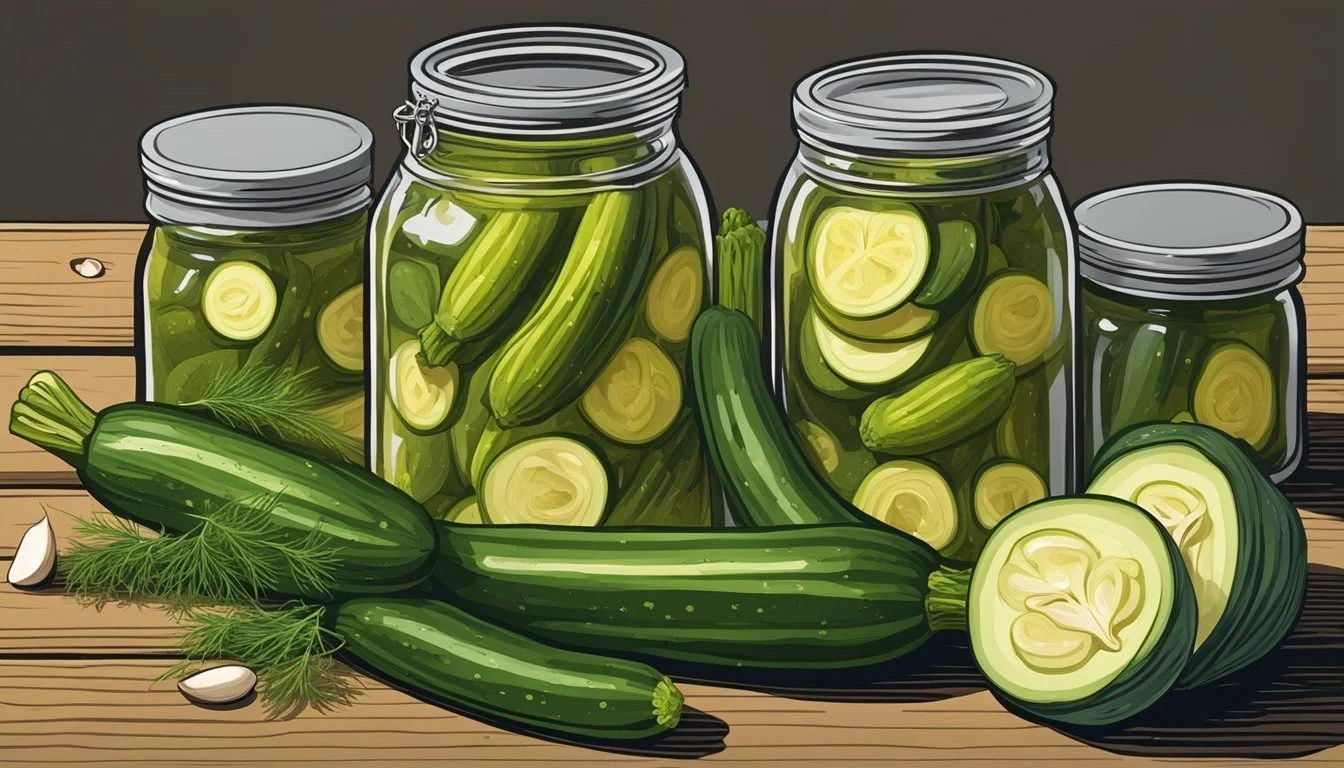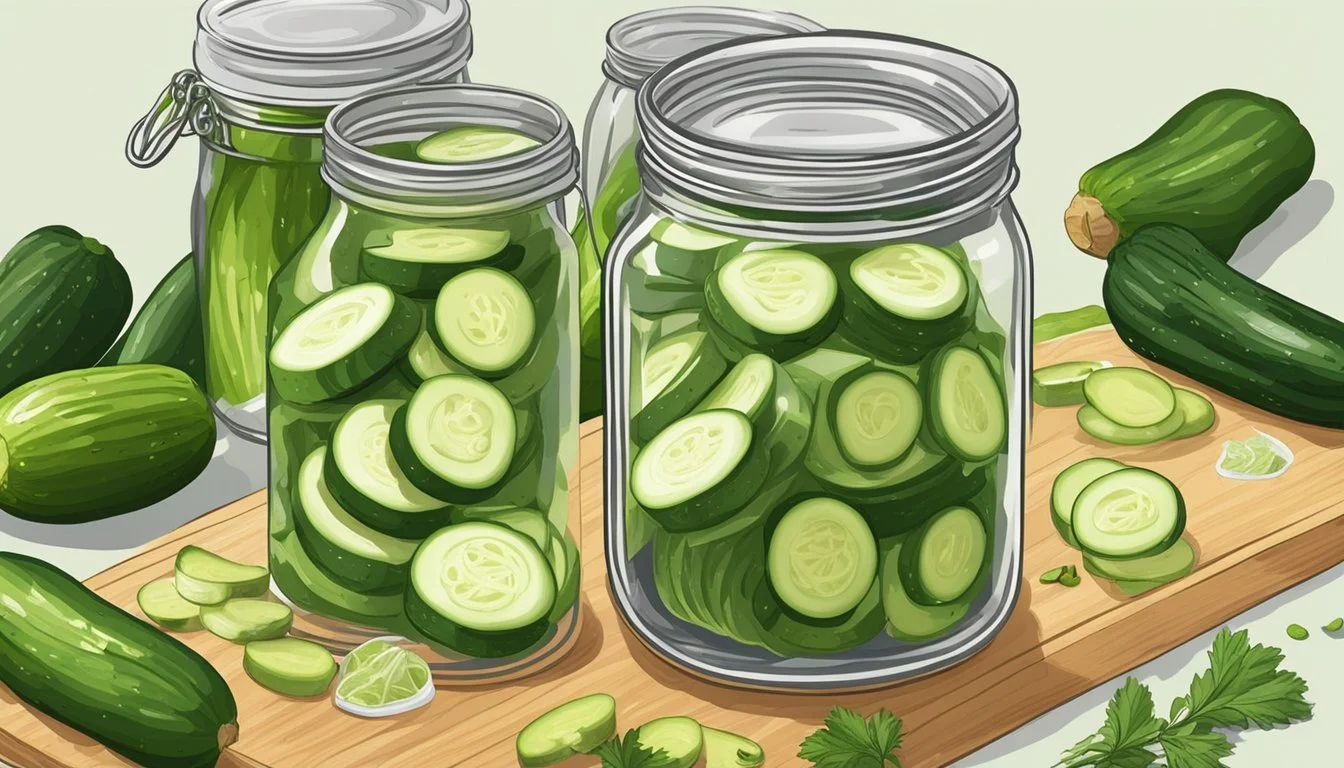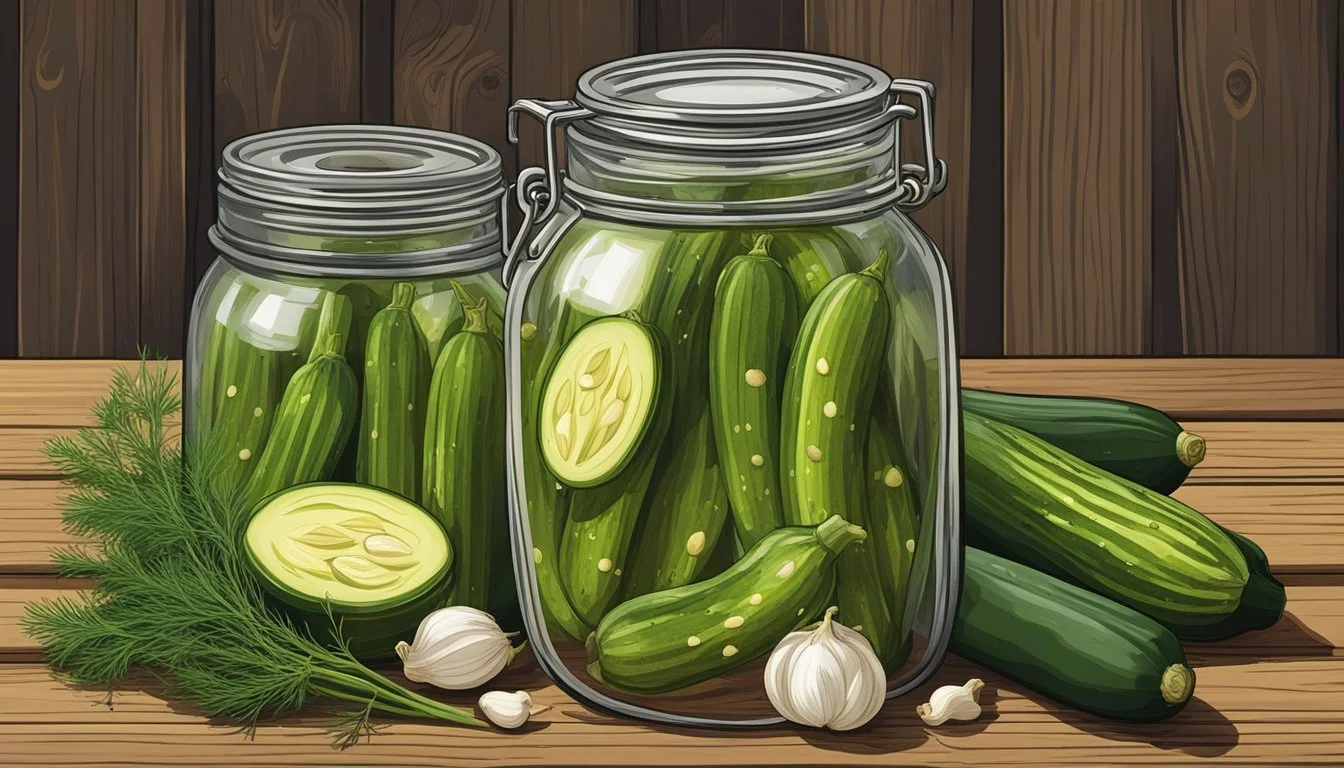Zucchini End Pickles
A Crunchy, Tangy Condiment Unveiled
Zucchini (What wine goes well with zucchini?) end pickles are an exceptional way to transform the often-discarded ends of this versatile vegetable into a crunchy, tangy condiment. The process of pickling not only reduces waste but also enhances the zucchini, elevating it into a savory treat that can complement a variety of dishes. These pickles offer an easy, creative solution for those looking to add a burst of flavor to their meals without the need for complex preparation.
The appeal of pickled zucchini lies in its textural contrast and the balance of flavors. By soaking zucchini ends in a brine of vinegar, sugar, and select seasonings, the pickles acquire a firm bite and a delightful tanginess. The result is a condiment that pairs wonderfully with sandwiches, wraps, and cheese platters, and can even be savored straight from the jar as a refreshing snack.
Zucchini pickles are a testament to the versatility of pickling as a culinary technique, allowing the simple zucchini to stand out in a new light. This method of preservation not only extends the shelf-life of the vegetable but also infuses it with a unique character that is both delectable and memorable. Whether used in a casual setting or as part of a gourmet spread, zucchini end pickles are a delectable addition to any food lover's pantry.
The Basics of Zucchini Pickles
In this section, we explore the simple process by which zucchini transforms into a flavorful condiment. Zucchini pickles strike a balance between tanginess and crunch, offering a versatile topping or side.
Understanding Zucchini Pickles
Zucchini pickles are a type of preserved vegetable where slices of zucchini are submerged in a vinegar-based brine. The pickling process not only extends the shelf life of zucchini but also enhances its flavor and texture. Unlike traditional cucumber pickles, zucchini pickles have a unique, slightly more tender texture and a capacity to absorb an array of spices and flavors.
Essential Ingredients
The key ingredients for making zucchini pickles are:
Zucchini: Fresh and firm zucchini are the best choice for pickling.
Water: It's a vital part of the brine, used to dilute the vinegar.
Salt: Kosher or pickling salt is preferred for its purity.
Sugar: It adds sweetness to balance the vinegar's acidity.
Vinegar: Acts as the pickling agent to preserve the zucchini.
Creating the perfect zucchini pickle requires a balance of these ingredients to achieve the desired taste and consistency.
The Role of Vinegar in Pickling
Vinegar is crucial in the pickling process as it provides the acidic environment necessary for preservation. This acidity helps to prevent the growth of bacteria, ensuring the pickles are safe to consume. The type of vinegar used can vary, with common choices including white distilled vinegar, apple cider vinegar, or other flavored vinegars to impart different tastes to the pickles. The proportion of water to vinegar in the brine affects both the pickles' safety and their tanginess.
Preparing Zucchinis for Pickles
When making zucchini pickles, it's vital to start with the right produce and techniques. The preparation phase ensures the zucchinis are properly seasoned and cut to create a crunchy and tangy condiment.
Selecting the Right Zucchinis
The ideal zucchinis for pickling are fresh from the garden, firm to the touch, and have bright green skin. Small to medium-sized zucchinis are best, as they tend to be more tender and less seedy. Avoid overripe zucchinis as they can become mushy when pickled.
Slicing Techniques
Using a mandoline or a sharp knife, one cuts zucchini into consistent slices, which is crucial for even pickling. The thickness of the slice impacts the final texture, with thinner slices becoming softer, and thicker slices remaining crunchier. Here are common slicing options:
Paper-thin rounds (using a mandoline)
1/4 inch slices for thicker, crunchier pickles
Uniformity in sliced zucchini aids in evenly distributing the flavors during the pickling process.
Salt and Its Importance
Salt is essential for flavor and to draw out moisture from the zucchini, which helps in the preservation process. It's important to use non-iodized salt, such as kosher salt, sea salt, or pickling salt, as they do not contain additives that can cloud the brine or alter the flavor. Sprinkle the salt over the sliced zucchini and let it sit, typically for a couple of hours, to wilt the vegetables slightly before pickling. This step helps ensure a crisp final product.
Crafting the Perfect Brine
The foundation of any great zucchini end pickle is its brine, a delicate balance of acidity, salinity, sweetness, and seasoning that infuses the pickles with flavor and preserves them.
Creating a Balanced Brine
A balanced brine for zucchini end pickles achieves the right harmony between water, salt, sugar, and vinegar. The brine’s base typically consists of equal parts water and vinegar, which can be adjusted depending on the desired level of tanginess. For the vinegar component, one can choose apple cider vinegar for a fruitier undertone or white vinegar for a sharper taste.
Here's how to get started:
Water: 1 cup
White vinegar or apple cider vinegar: 1 cup
Kosher salt: 1 tablespoon
Sugar (optional): 1 to 2 teaspoons
One should heat the mixture, stirring until the salt, and optionally sugar, are completely dissolved. The dissolved salt acts as a preservative and flavor agent, while the sugar can slightly mellow the sharpness of the vinegar.
Flavor Enhancements with Spices
The choice of spices can elevate zucchini pickles from good to extraordinary. Essential spices include mustard seeds, black peppercorns, and coriander seeds, each adding their unique flavor notes. Dill seed or fresh dill springs bring in a herbaceous note, while garlic adds pungency. For warmth and complexity, one may add turmeric, dry mustard, celery seed, allspice berries, or bay leaves.
One should proportion the spices as follows:
Mustard seeds: 1 teaspoon
Black peppercorns: 1 teaspoon
Coriander seeds: 1/2 teaspoon
Dill (fresh or seed): 2 sprigs or 1/2 teaspoon
Garlic, minced: 1 clove
Optional: a pinch each of turmeric, dry mustard, celery seed, allspice berries, and 1-2 bay leaves
Spices are layered into the jar before packing in the zucchini ends. After heating the brine, it is carefully poured over the spices and zucchini, ensuring the flavors meld beautifully as the mixture cools and pickles.
The Pickling Process
The process of transforming zucchini into a crunchy and tangy condiment involves canning methods or simple refrigeration. Each method impacts the shelf-life and flavor of the final product.
Traditional Canning Method
Canning is a preservation technique that extends the shelf-life of food, making it suitable for long-term storage. For zucchini pickles, one begins by sterilizing mason jars and lids in boiling water to prevent bacterial growth. The zucchini and any additional flavorings are then packed into these jars, leaving suitable head space. A pickling brine, typically a mix of vinegar, water, and white sugar, is brought to a boil and then poured over the vegetables in the jars to constitute the pickling liquid. The jars are sealed and processed in a boiling water bath for a time specific to the recipe, which will ensure a proper seal and allow the zucchini pickles to be stored at room temperature until opened.
Ingredients for Brine:
Vinegar
Water
White sugar
Supplies Needed:
Mason jars with lids
Large pot for boiling water bath
Refrigerator Pickles
Refrigerator pickles offer a quicker alternative with less equipment required. After slicing the zucchini and optionally onions, vegetables are commonly mixed with salt and left to sit, which helps to draw out excess moisture. The vegetables are then drained, patted dry, and packed into pint jars. The hot pickling brine is prepared similarly as with the traditional method but without the need for a water bath. Once poured over the zucchini in the jars and sealed, the refrigerator zucchini pickles need only to be stored in the refrigerator where they will develop their flavors over several hours or days, depending on the recipe.
Steps to Prepare Refrigerator Zucchini Pickles:
Slice zucchini and mix with salt.
Drain and dry the vegetables.
Pack into pint jars and cover with hot brine.
Seal and refrigerate.
Understanding Pickling Times
The duration for which zucchini is left to pickle will affect its texture and flavor. Refrigerator pickles can be ready to consume within a few hours, delivering a crisp texture ideal for adding to sandwiches or serving as a fresh condiment. In contrast, traditionally canned pickles require several weeks to properly develop their flavors. It's essential to follow specific recipe guidelines for optimum taste and food safety, regardless of the pickling method chosen.
Serving and Pairing Zucchini Pickles
Zucchini pickles offer a refreshing crunch and tang that can enhance various dishes and appetizers. They are versatile in use and can complement a broad range of flavors.
Incorporating into Dishes
Zucchini pickles, with their crisp texture and slightly tangy flavor, can be sliced or chopped and used to elevate the taste of burgers and sandwiches. They introduce a contrasting flavor profile that works particularly well with rich, savory meats. When tossed into a salad, pickled zucchini adds a zesty twist and can be an intriguing substitute for cucumber pickles. For those who enjoy Italian cuisine, incorporating zucchini pickles into pasta dishes provides a surprising burst of flavor that cuts through creamy or tomato-based sauces. (What wine goes well with tomato-based sauces?)
Accompaniments & Presentation
When presenting zucchini pickles on a cheese board or charcuterie (What wine goes well with charcuterie?) board, it's advisable to pair them with milder cheeses, such as goat cheese, to balance their bold flavor without overwhelming the palate. The pickles can also be served as a relish alongside artisan breads and crackers. Sprinkle with red pepper flakes for an extra kick if desired.
Cheese Board Presentation:
Goat Cheese
Brie
Gouda
Crackers
Zucchini Pickles
Optional: drizzle of honey
By offering a variety of pairings, zucchini pickles can suit many tastes and dietary preferences, enhancing the dining experience with their distinctly pickled zest.
Special Tips and Variations
Crafting the perfect batch of zucchini end pickles allows for personalization and experimentation. Adjusting spice levels and exploring alternative pickling methods can significantly impact the flavor profile and crunch of the pickles.
Adjusting Spice Levels
Adjusting the heat in zucchini pickles is a simple matter of spice manipulation.
Sugar: Modifying the sweetness can balance spiciness. Increasing granulated sugar mitigates heat.
Vinegar: Selection of vinegar affects tanginess. White wine vinegar imparts a milder taste, while balsamic vinegar contributes a robust flavor.
Spices: For a hotter kick, red pepper flakes or crushed red pepper flakes can be added. To soften the intensity, reduce the amount used.
Herbs: Dill, especially fresh dill, introduces a refreshing note. Use it generously for a cooling effect.
Table for Spice Adjustment:
Ingredient Mild Variation Bold Variation Sugar Increase Maintain Standard Ratio Vinegar White wine vinegar Balsamic vinegar Red Pepper Flakes Omit 1-2 tsp (to taste) Black Peppercorns 1/2 tsp per jar 1 tsp per jar Fresh Dill 2-3 sprigs per jar 1 sprig per jar Mustard Seeds Yellow mustard seeds Black mustard seeds
Alternative Pickling Methods
Regardless of the preferred method, ensuring a no-heat option is available can accommodate those sensitive to spice and heat.
Cold Brine: For a vibrant crunch, a cold brine method where no heating of the pickling liquid is involved preserves the zucchini's natural texture.
Heat Process: For those preferring softer pickles, a heated brine can be utilized. Combine water with pickling ingredients like vinegar, mustard seeds, and granulated sugar until dissolved.
Seasoning Adjustments: Experiment with aromatics like garlic or coriander for different notes. Ground mustard can also replace mustard seeds for a more intense flavor without altering the texture.
Using these tips and variations, one can create a condiment that reflects personal taste preferences while achieving the ideal balance of crunch and zest.
Storing Zucchini Pickles
Storing zucchini pickles correctly ensures their longevity and preservation of their unique crunchy texture and tangy flavor. Proper storage involves refrigeration and can include freezing for extended shelf life.
Shelf Life and Refrigeration
Freshly packed zucchini pickles should be stored in the refrigerator to maintain their crispness and prevent spoilage. Ideally, one should use glass jars, such as mason jars, for storage because glass is non-reactive and does not absorb flavors or odors. After sealing the pickles in the jars, placing them in the refrigerator is crucial.
Shelf life in the refrigerator: Typically, refrigerated zucchini pickles retain their best quality for up to two months.
Container: Use airtight pint-sized mason jars or larger, depending on the batch size.
Temperature: Keep refrigerated at or below 40°F (4°C).
Freezing and Long-Term Storage
Although not a traditional method for pickle storage, one can freeze zucchini pickles for longer preservation. However, it's important to note that freezing may alter their texture.
Preparation for freezing: Ensure that the zucchini pickles are in a freezer-safe container, leaving some headspace to allow for expansion.
Shelf life in the freezer: Properly stored, they can last up to six months in the freezer.
Thawing: Defrost in the refrigerator overnight before use to minimize texture changes.
By adhering to these storage guidelines, zucchini pickles can be enjoyed as a crisp and tangy condiment long after they've been made.
Health Benefits and Dietary Considerations
Zucchini end pickles offer a healthy, flavorful addition to any meal, serving as both a source of essential nutrients and a versatile condiment for various diets.
Nutritional Information
Zucchini is known for being low in calories yet high in essential nutrients. It contains vitamin A, vitamin C, and traces of fiber, with the added benefits of antioxidants. Pickles, made through fermentation, can introduce beneficial probiotics which are good for the gut.
| Nutrient | Amount per 1 cup of sliced zucchini (approx.) |
|------------------|-----------------------------------------------|
| Calories | 19 |
| Protein | 1.5 grams |
| Fat | 0.2 grams |
| Carbohydrates | 3.9 grams |
| Fiber | 1.3 grams |
| Vitamin A | 200 IU |
| Vitamin C | 20.4 mg |
Vegetarian and Vegan-Friendly Recipes
Zucchini end pickles are an excellent condiment for those on a vegetarian or vegan diet. They are made without any animal products, adhering to the principles of plant-based nutrition. The fermentation process does not require any non-vegan additives, making it suitable for vegan consumption.
Gluten-Free and Allergen Information
For individuals with celiac disease or a gluten sensitivity, zucchini end pickles are a safe, gluten-free option. They are naturally free of gluten and can be prepared without any cross-contamination. Additionally, zucchini is not a common allergen, and, unless cross-contamination with allergenic substances occurs during the pickling process, these pickles should be allergen-free. However, consumers should always check labels for specific allergen information.
Beyond the Pickle Jar
Zucchini pickles, with their crisp texture and tangy flavor, can be more than just a stand-alone snack. They lend themselves to a variety of culinary applications, from enhancing everyday dishes to becoming a key ingredient in homemade condiments.
Creative Uses in Cooking
Zucchini pickles can elevate the taste profile of numerous dishes. Their crunchy texture and zestiness make them a dynamic addition to sandwiches, offering a pleasant contrast to deli meats or cheeses. Moreover, they can be chopped finely to create a relish that pairs beautifully with grilled meats or hot dogs, mirroring the classic use of bread and butter pickles.
Zucchini Bread: Incorporate diced zucchini pickles into the batter for a savory twist on the traditional zucchini bread. The pickled pieces add a surprising burst of flavor in every bite.
Zucchini Muffins: For those who appreciate a balance of sweet and savory, adding finely chopped pickles to zucchini muffin mix brings a fresh take to this breakfast favorite.
Zucchini Pickles in Home-Brewed Condiments
Home chefs can use pickled zucchini as a foundational component in making unique condiments. They can experiment by pureeing the pickles to create a tangy spread for artisanal breads or blending them into mayonnaise for a homemade tartar sauce.
Aioli: Blend pureed zucchini pickles with garlic, mayonnaise, and lemon juice for a flavorful aioli perfect for dipping fries or as a spread for gourmet burgers.
Vinaigrette: A zucchini pickle vinaigrette, made with olive oil, the brine from the pickled zucchini, and a touch of mustard, can add zest to salads or act as a marinade for vegetables and proteins.
Community and Culture
In kitchens and gardens worldwide, zucchini pickles have become a beloved condiment, crystallizing the intersection of culinary arts and sustainable practices. They embody a rich tradition that transcends the boundaries of home cooking and reaches into the larger community, celebrated in cookbooks and potlucks alike.
Zucchini Pickles in the Culinary Community
Popular in home kitchens and high-end restaurants, zucchini pickles offer a crunchy and tangy addition to many dishes. They are frequently seen in community food blogs and have secured their place in countless zucchini recipes, often earning a 5-star rating from enthusiasts. For many chefs, both amateur and professional, these pickles are a vibrant representation of versatility; they are just as at home on a charcuterie board as they are in a simple picnic sandwich.
Within the culinary community, they take center stage in farm-to-table cooking, emphasizing the use of fresh produce for optimum flavor. Noteworthy cookbooks dedicated to pickling and preserving highlight zucchini pickles for their unique taste and texture, offering creative ways to integrate them into daily meals.
Gardening and Farm-to-Table Movements
The rise of gardening and farm-to-table movements has brought new attention to the value of growing and utilizing fresh produce. Zucchini is a garden favorite, praised for its abundant yield and ease of growth. It serves beautifully in a garden-to-table journey, from planting seeds to harvesting the squash for pickling.
Communities focused on sustainability often encourage gardening, and the process of making zucchini pickles becomes an educational opportunity. It highlights the importance of seasonal ingredients and preserving excess produce. In farm-to-table initiatives, zucchini pickles exemplify how local produce can be transformed and savored year-round, adding an element of self-sufficiency to community dining.
Troubleshooting Common Issues
In the process of making Zucchini End Pickles, enthusiasts may encounter issues like lack of crunchiness or unbalanced flavors. Addressing these concerns promptly can ensure the satisfaction of creating a perfectly tangy and crisp condiment.
Pickles Lacking Crunch
The crunch of a pickle is paramount. If the pickles turn out soft, one should look at the processing method and the freshness of the zucchini. Ensuring that the brine is at the optimal temperature of 165-180 degrees Fahrenheit before adding the zucchini can make a difference. Overcooking or using high temperatures (above 185º F) can result in softening the pickles. It is essential to use fresh zucchini as older ones may lead to a softer texture. Additionally, after cutting the zucchini into slices or sticks, soak them in ice water for an hour before draining and adding to the jars to help them crisp up.
Adjusting for Overly Salty or Sweet Flavors
Flavor balance is critical in Zucchini End Pickles; too much salt or sugar can overpower the natural taste of the zucchini. If the brine is overly salty, one can dilute it with a little water or vinegar and then taste again. For a too sweet brine, one can add a bit more vinegar to balance the sweetness. Conversely, if the pickles are not salty or sweet enough, it is advisable to incrementally adjust the levels, adding small amounts of salt or sugar, then tasting and reassessing.
It's imperative to record any adjustments made during the troubleshooting process. This will provide guidance for future batches, ensuring every jar of Zucchini End Pickles turns out with a satisfying crunch and a harmoniously balanced flavor.







